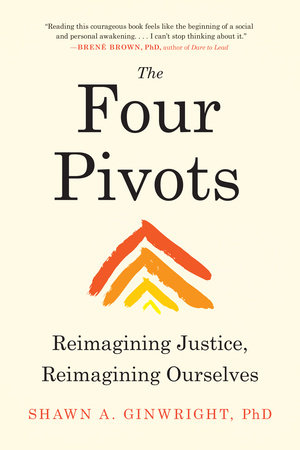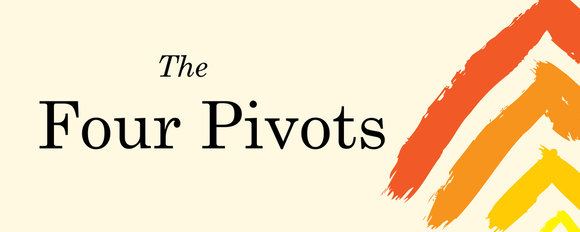

By Shawn A. Ginwright, author of The Four Pivots: Reimagining Justice, Reimagining Ourselves
We need a fundamental shift in our values, a pivot in how we think, connect, act, and work. A pivot is a small change in direction from a single point where we are. It means that through one small change in direction, over time we can get to where we want to be. A pivot is not a complete abandonment of what we know, but it braids together what we know with how we feel and who we wish to be. For example, in basketball a pivot requires four interwoven and seamless traits. When a player has the ball, they pivot in order to advance the ball down the court. This pivot requires that (1) they stop momentarily and reflect on what is happening, (2) they have awareness of the relationships of other players around them, (3) they maintain focus on the goal without distraction, and (4) they calmly and confidently flow into another direction. You don’t see all of this of course because it all happens in an instant.
That’s what we need as individuals, as communities, and as a society. A pivot acknowledges collective harm and individual injury but also leans into the future and opens entirely new possibilities. A pivot involves renewing our sense of possibility, transforming how we see the world, and shifting the values of our culture. This can only happen when we foster a collective imagination that restores communal wisdom that embraces both imagination and engagement, empathy and power, reflection and action. A pivot means that we need to dream higher about the future we want to create.
This book is about the pivots we need to make as individuals, as communities, and as a society. I’ve come to know these pivots both professionally in my work with organizations and communities and personally in raising two beautiful children, in my relationship with my wife of nearly thirty years, and in my relationships with close friends. Just to keep it real, I struggle with these pivots and don’t claim that they come easy to me. I don’t want you to think that I walk through the world as an example of how to live, work, and play using the pivots that will guide your journey through this book. I do want you to know that perfection (living in our perfect pivots) is not the goal in my writing this book. Rather, it’s a commitment to an imperfect journey.
Your journey in this book is composed of four pivots. The first section focuses on the pivot in our awareness: from lens to mirror. Instead of viewing the world through a thick lens—that is, as analysts of social problems—we must view it as a mirror of ourselves. This involves the practice of self-reflection and exploration of who we are as individuals and how we contribute to the world we wish to create. The second section is dedicated to a pivot in our connection: from transactional to transformative relationships. Most of us have been trained to lead and work with others in highly technical ways. Transactional relationships are efficient for work and productivity but insufficient for healing. Transformative relationships in our professional and personal lives cultivate deeper human connection through vulnerability, empathy, and listening. The third section highlights a pivot in vision: from problem fixing to possibility creating. As I discussed earlier, the history of exclusion, a scarcity mindset, and zero-sum thinking resulting from inequality come with a psychic cost. We have been socialized to focus on fixing problems and not on creating entirely new possibilities. The last section is committed to a pivot in presence: from hustle to flow. This involves transforming our addiction to frenzy, which is one toxic result of our capitalist culture, to an existence of calm well-being. We all know what it feels like to be addicted to frenzy, whether we love staying busy or have to hustle for survival. We are always busy, behind on pesky tasks, overcommitted, and in a rush to the next meeting or event. If we can admit it to ourselves, we know deep down that we get a great deal of satisfaction from our addiction to frenzy. This is because we say to ourselves, “If I’m busy, I’m important and I matter.” Like any addiction, however, this gratification obscures the core truth: that our addiction to frenzy gets in the way of our healing and well-being. A shift to well-being means we reclaim our right to be well. We slow down the pace of our day, we say no more often and without guilt, and we take a nap every now and then!
At the end of each section, you’ll have an opportunity to do some work. I’ve included a few activities and lessons that can support you in making these pivots. Think of these activities as guardrails that help you along the path and steer you in the right direction. I’ve included these activities because so many times I’ve heard the questions “What do I do? And how do I use these pivots?” These lessons are meant for you to practice, practice, practice and discover how these pivots can make a difference in your work and life. They are also designed to push, nudge, and cajole a new way of thinking about work, relationships, and social change. I suggest that you read this with your colleagues at work or your friends to share what you are learning. I hope that by practicing ways to reflect, create belonging, cultivate vision, and foster empathy, we can build the momentum we need to ultimately transform our culture.
